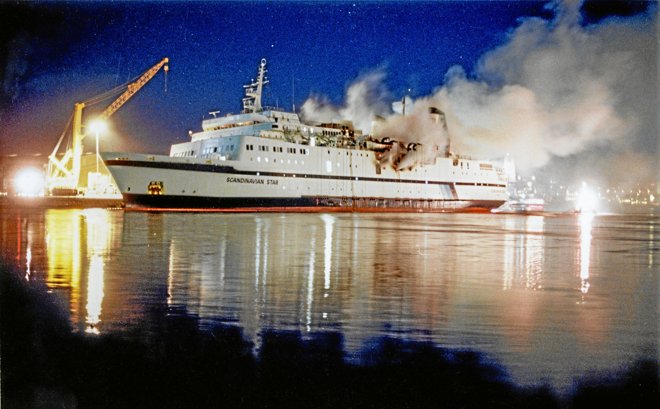After 34 years: Here are the brand-new revelations about the Scandinavian Star

It is unlikely that insurance fraud was the motive behind the arson on board the 'Scandinavian Star.'
This is the conclusion of the investigation which Taskforce Scandinavian Star has just published.
All persons in the ownership circle of the ferry would have made more money by keeping the ferry in continuous operation than by having it destroyed by a fire and receiving the insurance amount.
On the other hand, the investigation levels devastating criticism at both the Maritime Authority and the relevant ministries that have been responsible for mapping out the many years of aftermath after the tragedy.
Regarding the suspicion of insurance fraud as a motive that has been put forward over many years, the investigation states:
"On this basis, it can be stated that the arsons on April 7, 1990, could not likely have been motivated by bringing the Scandinavian Star's hull insurance to payment. The concluded insurance agreements, the hull insurance sums, the hull compromise, alternative courses of action, as well as the seller's and buyer's financial interest in the continued operation of the ferry, argue against such a motive.
About the actions of the Maritime Authority, the investigation writes:
"We assess that the lack of recognition and management of the risk of authority impartiality at the Maritime Authority, not just by the Authority itself but also by the relevant ministries, is not just regrettable but also subject to criticism, and that it is likely to create mistrust in the Maritime Authority's administration and case handling in the decades following the fire."
Covers up negligence
Among the primary tasks of the task force has been to clarify whether a motive of insurance fraud could be demonstrated as an initiator behind the tragic fire.
Additionally, investigators have worked to uncover whether the state authority, the Maritime Authority, at the time failed in its responsibility by not inspecting the ferry before it entered passenger service and whether the Maritime Authority subsequently attempted to cover up its possible negligence.
The investigation assesses that the Maritime Authority could and should have boarded the ship—and conducted an inspection—before its first departure with passengers. Had this occurred, the investigation states, a number of irregularities would have been observed, and based on this, it would have been standard procedure to proceed with a more in-depth inspection and also to require the ship and its crew to engage in a comprehensive fire drill before permission for passenger operations was granted. This would have, at a minimum, ensured that the ship and crew would have been much better prepared on the night the fire was ignited.
"We therefore find it proven that the implementation of a port state control would have resulted in a fire drill being conducted. The fire drill would have prepared the crew to better handle the consequences of the arson on April 7, 1990."
However, the investigation assesses that even an expanded inspection and demand for fire drills would not have been able to delay the first departure with passengers. The arsons would not have been prevented:
"But it would likely have reduced the extent of the disaster and given the passengers better chances of survival."
The harshest criticism
However, the harshest criticism concerns the apparent self-closure of the Maritime Authority in the following years. Apparently, for the authority, it has been more about covering up its own failures than acting in the service of the public.
The report states:
"It appears that an understanding solidified within the Maritime Authority that the authority was not obliged to ensure that a passenger ferry, which was under renovation, had new crew and was to enter into regular service from a Danish port, would be inspected before its first departure with passengers. This became the official stance of the authority, and it was not challenged. Information and documentation contrary to this stance were, over time, largely filtered out."
Ineligible since 1991
Already in 1991, an official report concluded that the Maritime Authority should have carried out a port state control on the ferry. Thus, the authority suddenly became an accused party in the case, entering so-called official disqualification. Nevertheless, the authority continued to advise the government and respond to citizen inquiries - even when the inquiries tried to uncover the Maritime Authority's possible responsibility.
The report has uncovered more than 100 examples of the authority processing cases in which there was a looming danger of being disqualified.
"The Maritime Authority was, or risked being, disqualified in matters concerning the criticism of the investigation committee. The authority did not make this known. Coupled with the degradation in communication about the criticism which we have established, it creates regrettable doubt about the correctness in the authority's case processing and ministerial servicing."
The Task Force Scandinavian Star has also investigated the many claims that have purported to document that several persons have worked on either to keep the serious fires going or even reignite the fires in the days after the tragedy. There have been allegations of suspicious behavior from the crew during the fire as well as much focus on possible sabotage of a hydraulic oil pipe, which supposedly should have caused an explosive fuelling of the fire.
However, the task force concludes in both cases that there is no evidence for these suspicions.




























